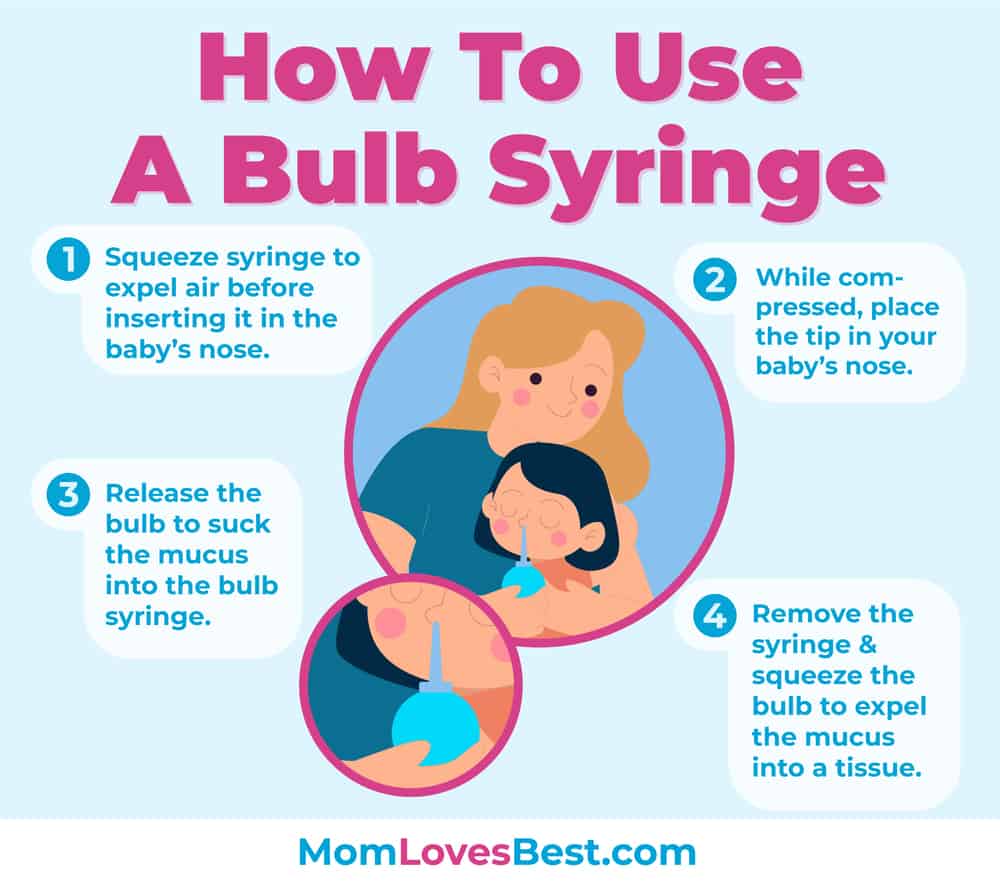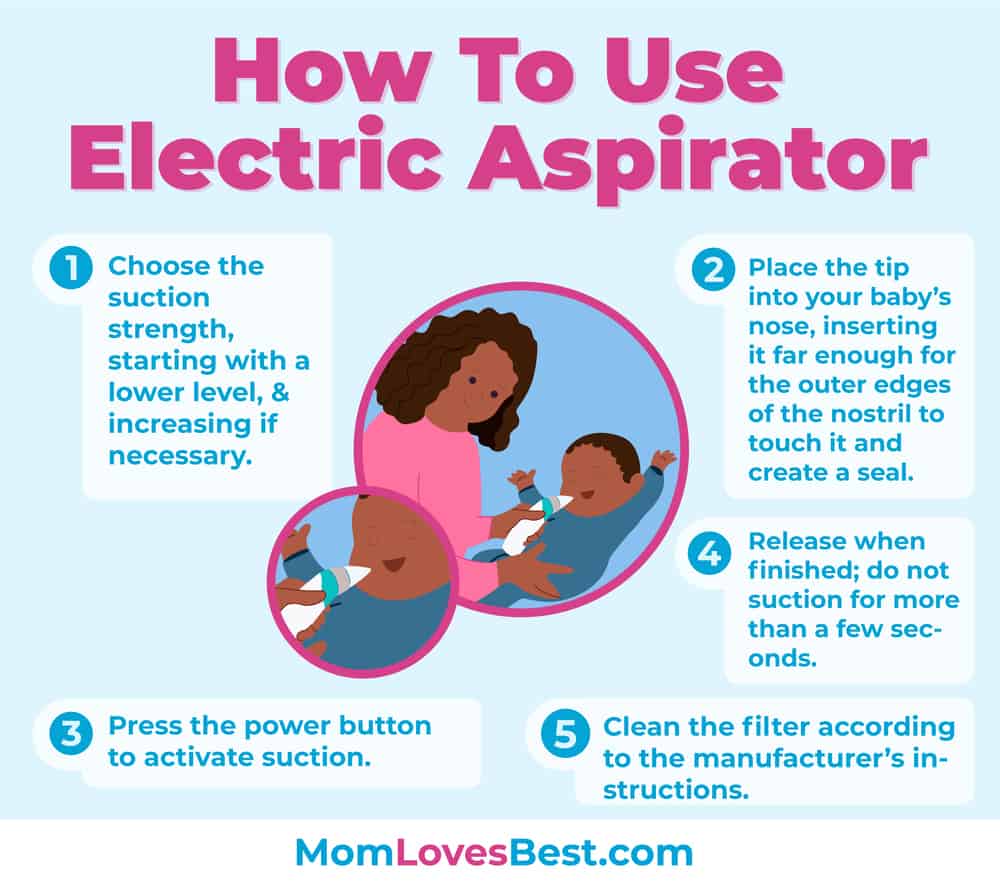How To Get Snot Out Of Baby Nose Without Syringe
Does your baby hate having a blocked up nose?
Most babies get a little bit cranky when they can't breathe properly. They have tiny nasal passages which can get blocked fairly easily. So, if your baby is snorting, having trouble eating, or seems a little more irritable than usual, it might be their nose.
We'll discuss some of the ways you can clean your little one's nose, so you'll know exactly what to do next time your infant is all stuffed up.
- The Causes of Baby Congestion
- How to Clean Baby's Nose
- How to Prevent Baby Congestion
- Remedies You Shouldn't Try
- When to Call the Doctor
- In Conclusion
The Causes of Baby Congestion
Having a newborn that isn't feeling well can be pretty disheartening. When a baby has a stuffed nose, they sometimes don't even want to eat. This can be very worrisome, particularly for a new mom.
There are many reasons why your baby's nose could be clogged, however. Not all of them relate to being sick. Here are five of the more common reasons a baby has difficulty breathing through the nose:
- The nasal passages are small: Your newborn's beautiful button nose is pretty tiny. So it takes very little mucus to block the nasal passage, and it can sound quite congested. If your baby is eating without a problem and looks otherwise well, there may not be that much actually clogging it, not to worry.
- Babies can't blow: Mucus builds up in the nose sometimes for all sorts of reasons, no matter what your age. Older children and adults can just simply blow it out into a tissue. However, babies can't, and they need another way to help clear their nasal passages.
- Things are irritating the nose: Perfumes, cigarette smoke, pet dander, pollen, or dust can all cause irritation of the nasal passages. Try to eliminate these and make sure that your baby is breathing good quality air (1).
- They have a cold: Babies are susceptible to the cold virus just like everyone else. So, if your baby has all the stuffed up symptoms, especially if someone in the family has recently had a viral infection, it could be the common cold.
- They have a more serious illness: Respiratory syncytial virus (RSV) can cause your baby to be congested, along with a cough, and suffer from some degree of difficulty breathing, creating an illness we call bronchiolitis. It'll usually be accompanied by other signs, like fever, irritability, and disrupted feeding patterns (2). Influenza and pneumonia are also infections that can cause respiratory difficulties and should be monitored closely and treated when indicated. When a baby is very ill and not able to breathe well, they will have a lot of difficulty feeding and can get dehydrated, especially when they also have a fever.
How to Clean Baby's Nose
When your nose is stuffed, the best remedy is to blow it out. This is not possible for your baby to do, however. That's why you need these alternative clearing methods.
1. Nasal Spray
A saline nasal spray or drops are a great way to clean your baby's nose. They work by thinning out the mucus, which will usually help clear the congestion temporarily (3). Pediatricians typically recommend the drops for babies, as they give you a little more control over the amount administered and the force with which they go into the nose.
In order to use the drops, you'll need to lay your baby down on their back. With a hand or pillow under the neck, tilt their head back. You want it to be at a slight angle.
Next, you should put one or two drops of the saline into each nostril. Then wait a few minutes before turning your baby onto their stomach. The mucus should start flowing at this point. If not, it is also helpful to use the nasal bulb syringe as explained in the following section and demonstrated in the video below.
You can use a soft tissue or cloth to wipe away any excess mucus or saline that runs out of the nose. Your baby is probably not going to like the process, but will usually be much happier when it's easier to breathe again.
2. Bulb Syringe
Chances are you've seen one of these bulb syringes before. They often come in a baby grooming kit, or you may have been given one in the hospital. The rubber bulb syringe is made specifically for clearing your baby's nose.

Lay your baby on their back on a flat surface facing upward. Make your little one is comfortable and relaxed.
Squeeze all the air out of the bulb. It should be pretty flat in your hand, and then gently place the tip into your baby's nose. Take care that you don't insert it too deeply, but enough to make a seal around it to allow some suction to be created.
You may then release the squeeze on the bulb. This will suck the mucus out of the baby's nose and into the bulb. Have a cloth nearby so you can squeeze out the contents of the bulb before using it on the other nostril. Watch this video for a demonstration of a good method for using a bulb syringe to clear out your baby's nostrils.
You need to clean the bulb out after each use to prevent the spread of any germs. It is important to take care of the syringe properly, allowing it to drain and dry out between uses.
3. Nasal Aspirator

A nasal aspirator works in a similar manner to the bulb syringe. However, instead of using the pressure inside the bulb, you will provide the suction yourself. The aspirator has a tube with a mouthpiece for you to gently suck the mucus out of your baby's nose.
You will use the same manner as the syringe, being careful not to place the tip too far inside the nostril. When you're sucking on the tube, you probably don't want to use too much force. This could cause your baby to have inflammation inside the nose. Once you get used to doing it, you should find you can control it pretty well.
A good tip that I learned from my pediatrician is to use some drops of the saline solution to loosen the mucus first, and then use the aspirator to bring it out. The video in the section above, after teaching the use of the bulb syringe, goes on to give a live demonstration of how to use a nasal aspirator.
Don't worry —most aspirators have a filter inside the tube to prevent the mucus from making its way into your mouth. It may feel weird sucking boogers out of your little one's nose, but it's really effective. Just like the syringe, you'll need to clean it before and after each use.
4. When Should You Clear Your Baby's Nose?
The use of saline drops and the bulb syringe or the nasal aspirator can be done 3 to 4 times in a 24 hour period. Any more than that can carry a risk of damaging the lining of the nasal passages, causing irritation and nosebleeds.
It can be helpful to time these clean-out sessions just before feedings, to help your baby breathe while nursing or taking the bottle. It's just not possible to suck and breathe through the mouth at the same time, so babies must have clear noses in order to get in a good feeding. In fact, one of the reasons babies do not feed well with respiratory illnesses is that it is just too much effort. So you will notice they feed for shorter periods of time, just until they get tired of working so hard. And you will want to try and feed them more frequently when this is happening.
Another good time to clear nasal secretions is just before bed at night to help everyone sleep just a bit better.
5. Keeping Your Baby Safe
When using the bulb syringe or the nasal aspirator, there are a few precautions you should take. The process should always be very gentle and you should be calm.
Always start the process with freshly washed hands, just like you do with most things when dealing with babies. This will keep you from giving your baby any germs. Also, don't forget to wash your hands after clearing baby's secretions to prevent spread to yourself and others.
When you buy a syringe or aspirator, make sure it's specifically designed for babies. If the tip is too large, it could damage your little one's nostrils. Also, make sure to carefully follow any directions that come with your device.
How to Prevent Baby Congestion
Pediatricians recommend only using the suction methods a couple of times per day, to keep the delicate mucous membranes inside the nose from getting irritated and inflamed. If your baby has allergies or is ill, you may want to use other methods to keep the nose as clear as possible. Here are a few things you can do to help the nostrils drain more easily:
- Humidifier: Dry air in your home from the heater or the air conditioner can cause noses to become dry and then produce extra mucus. This problem is especially prevalent in the winter. Run a humidifier in your baby's room to moisten the mucus membranes in the nose and help alleviate the symptoms(4).
- Steam: Steam also can help loosen the mucus inside your baby's nose. Close the bathroom door and run hot shower water to make the room steamy. Then turn off the water and sit inside the steamy room with your baby for 5–10 minutes to let it penetrate the nostrils. You can also try a vaporizer to create warm steam in baby's bedroom for a similar effect while sleeping.
- Gravity: While your baby is taking a nap, try propping them up a little bit. You can use a folded or loosely rolled blanket under their head to give it a little elevation. This should only be done when you are awake and can see your baby and not during the nighttime hours. When baby is awake, tummy time can help the nose to drain, and help your baby developmentally at the same time!
Remedies You Shouldn't Try
There are many treatments for stuffy noses that are okay to use on adults. However, they may not be appropriate for use on your baby.
Neti pots are something that people use successfully to clear their nasal passages or deal with a sinus infection. But these should not be used on a baby. It will be too difficult to control the amount of saline solution you put in each nostril. The saline drops and bulb syringe work in a similar manner but can be used much more easily and safely with your baby.
Vapor rubs may be okay for older children or adults, but they're often not good for infants. The rubs usually contain ingredients like menthol or camphor, which are too harsh for a newborn's delicate skin. Also, a baby may accidentally get some of the ointment on their hands and into their eyes.
Decongestants and cold medicines are used by older children and adults occasionally to alleviate nasal congestion. These medications have demonstrated very little benefit for babies and have not been well-studied in infants and young children. The FDA has recommended caution due to potential overdose and toxic effects (5). The American Academy of Pediatrics has taken this a few steps further and, because of reports of harm outweighing the little benefit, recommends that they should not be used until after the age of 6 (6).

Editor's Note:
Dr. Gina Jansheski, MD, FAAP
When to Call the Doctor
Occasionally having blocked nasal passages is a common occurrence for babies, but there are times when the doctor should be called. Call and make an appointment with your baby's doctor for any of the following reasons:
- Your baby's symptoms last longer than a week.
- The condition seems to be getting worse instead of improving over time.
- Any efforts to clear the nostrils show no signs of improvement.
- The stuffiness continues, and you suspect it may be an allergy.
There are other methods your doctor may be able to try. They can look inside your little one's nose and see if anything is obstructing it. Plus, if it's a bacterial infection, your doctor can prescribe antibiotics. But keep in mind that most infectious causes of runny noses are viruses and antibiotics don't kill viruses.
There are a few scenarios that warrant prompt medical attention. If you notice any of the following symptoms, you should get your baby to a doctor immediately:
- You notice a blue tinge to your baby's skin, lips, or nails.
- Your baby is working too hard to take a breath.
- Your baby is running a fever or is coughing a lot.
- Your baby is unable to feed and may be getting dehydrated.
- You're concerned that a foreign object is stuck in your baby's nose.
In Conclusion
There really is no way to avoid nose cleaning. Your baby will have clogged nostrils at some point, and you will have to clear them out. After all, we all know how annoying having a blocked nose is.
Eliminating possible environmental factors may help. Also, you can prevent the spread of infections like the cold virus by having people wash their hands before holding your baby But if they are ill, remember these viruses are spread via respiratory droplets, so you don't want them to be close enough to breathe on your baby. It's probably best just to avoid such people altogether while they're unwell.
The at-home methods shouldn't be too difficult to perform, even though your baby won't enjoy them much. However, if you find that you can't get things clear, and your baby is obviously in distress, a call to the doctor may be in order.
How To Get Snot Out Of Baby Nose Without Syringe
Source: https://momlovesbest.com/clean-baby-nose
Posted by: gomezsonsen.blogspot.com

0 Response to "How To Get Snot Out Of Baby Nose Without Syringe"
Post a Comment